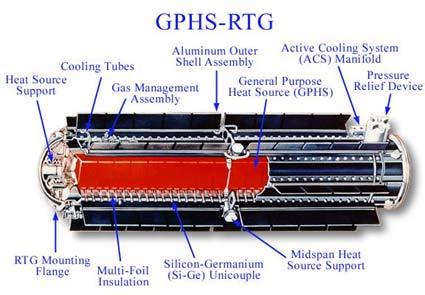
Home
Rocketry
Orbits
Technology
CEV
ISS
X-Prize
Virgin Galactic
RTG
Ion Propulsion
RadioIsotopse Generator

When the exploration of space extends far from our sun, it leaves little solar energy to power any craft in deep space. In fact, only about 1/1600th of the solar energy available on Earth is obtainable at the outer reaches of the solar system. This means that solar cells cannot provide sufficient power for scientific, mechanical or electronic systems. To this end, radioisotope generators were developed for satellites, first by the military, then by NASA beginning in the 1960’s. Modern onboard power sources are known as a general-purpose heat source radioisotope thermoelectric generator (GPHS-RTG) and are fuelled by a plutonium-238 dioxide, known commonly as plutonia. It is with the decay of the radioisotope that heat is generated to drive a thermoelectric converter. The first of the thermoelectric effects, or Seebeck Effect, occurs when junctions of a circuit made from two dissimilar metals are held at different temperatures; the potential difference (voltage) produced within the circuit drives a current in the closed circuit, and is proportional to the temperature difference at the junctions. Therefore, the power output of such a circuit is a function of the temperatures comprising the thermocouple (hot and cold junctions) and the thermoelectric material properties given by the Seebeck coefficients for the materials:
V = (QA – QB) (TH – TC)
where V is the voltage generated (Seebeck Voltage), QA & QB are the Seebeck coefficients (thermoelectric power, thermo power) for metals A & B respectively, TH is the temperature of the hot junction in Kelvin and TC is the temperature of the cold junction in Kelvin.
The GPHS-RTG used in modern spacecraft are thermoelectric converters comprised of several interchanging n- and p-type semiconductor thermo elements, connected in series by metal intersects, and sandwiched between two electrically insulating, thermally conducting ceramic plates. The temperature difference across the plates is maintained by the decay of the radioactive isotope to provide heat at the hot junction, while exposure to the cold of space, which can reach 33.15 Kelvin, maintains the temperature of the cold junction. Despite the nuclear and thermal radiation that can interfere with instruments (the reason it is kept away and shielded from other instruments) and weight of the power source, the benefit of the module over others is its reliable, maintenance free and relatively simple design, which to date has meant no mission failures credited to generators. Although the plutonium used to drive the thermoelectric circuit decays, having a half-life of 87.7 years; historically, RTGs have operated longer than their designed life with only the predictable decrease in power over time. Fortunately, as technology advances so has the ability to receive weaker communication signals; this has led to communications with spacecraft despite reduced power levels, further extending the length of their missions. Generally, each GPHS-RTG contains 18 heat source modules, with two 151-gram plutonia pellets per graphite shell and two shells per module. This means a generator uses roughly 10.9 kilograms of plutonia to provide around 250 watts of power at the beginning of the mission with a loss of 3 to 5 watts of power-generating capacity per year.
To shield craft systems from frigid temperatures of deep space, radioisotope heater units (RHUs) are designed for the sole purpose of providing approximately 1 watt of heat to protect instruments. RHUs operate on the same heat conduction principles as RTGs and coupled with a thermos bottle designs are quite effective at maintaining vital systems. RHUs are also very compact, measuring only 3.2 centimeters long, having a diameter of 2.6 centimeters and carry only about 2.7grams of fuel. These heater units are also lightweight, with the total device mass of around 40 grams and produce less electromagnetic interference than electrical heating systems.